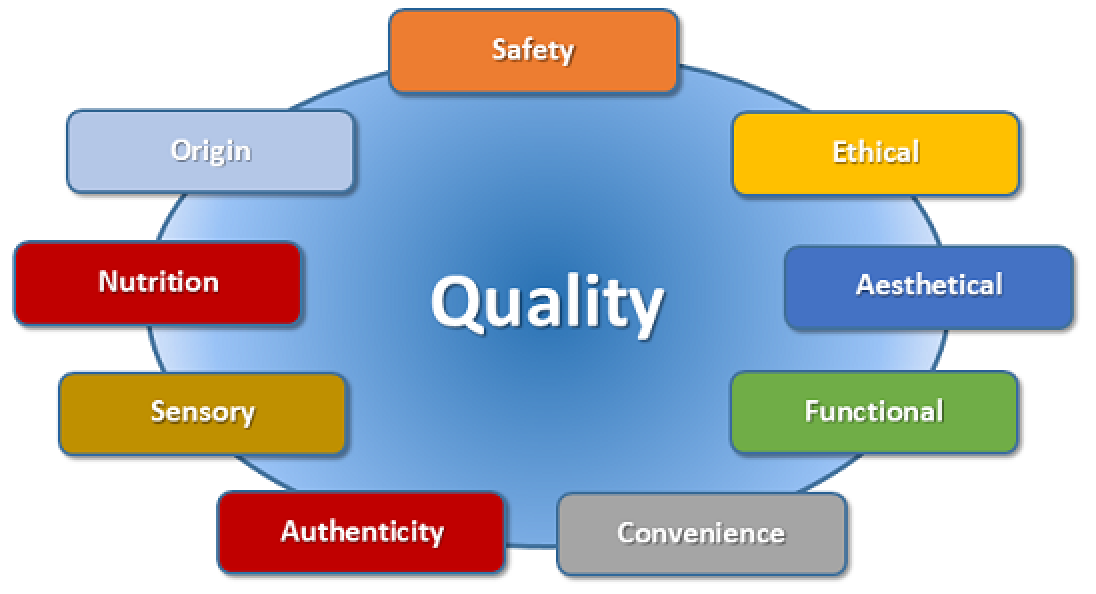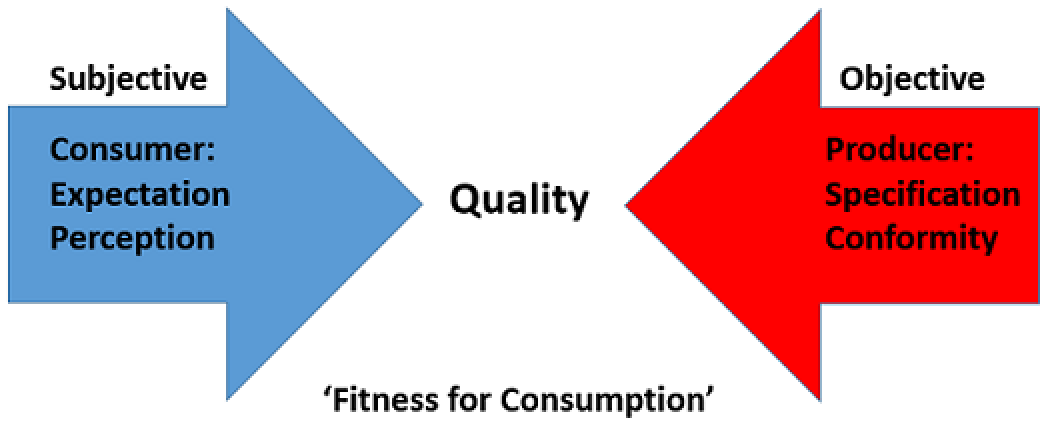Definition of Food Quality
The notion of food quality rests on a complex and multi-dimensional concept which is influenced by a wide range of situational and contextual factors. The characteristics contributing to food quality are depicted in the figure below.

The 24th Food and Agricultural Organisation of the United Nations (FAO) Regional Conference for Europe attempted to extend the general definition of quality, which can be found in standards of the International Standardization Organization (ISO), to food quality*:
- Historically, quality has been primarily understood as the absence of a defect, fraud and adulteration.
- More recently, quality rests on expected properties such as organoleptic and nutritional characteristics or resulting benefits. This introduces the need to take the legitimate expectations of users into account and to request operators to do likewise.
- Finally, quality designates desirable characteristics likely to justify added value; for example, forms of production (organic farming, environmental consideration, and animal welfare), production areas (designation of origin) and their associated traditions.
Dimension of Food Quality
Food quality has an objective dimension, which is the measurable physico-chemical characteristic inherent to a food product, and a subjective dimension framed by consumer expectations, perceptions, and acceptance ('fitness for consumption') (figure below).

Consumer expectations are based on quality cues (information stimuli) that are either intrinsic (e.g. inferring the ripeness of fruit from its colour) or extrinsic to the product (e.g. advertising, brand image). The better the match between the expectations consumers have before purchasing (expected quality) and the experience they obtain in using the products (experienced quality), the higher the level of consumer satisfaction. It has been demonstrated that positive experience with a brand reduces the risk of dissatisfaction and is frequently used to infer quality of the product*. Consequently, consumers often rely on well-known brand names as quality indicators*. Research has shown that consumers regard the taste and other sensory characteristics of food, health, convenience and the production process (e.g. organic, animal welfare, etc.) as the most important determinants of food quality*. In this respect, sensory properties (taste, aroma, etc.) were rated by 96% of 30.000 respondents in a German survey as the dominating dimension of food quality, followed by 'safety' (93%); 'freshness' and 'appealing appearance' were ranked third (92%) and fourth (87%) places respectively*. The 'Special Eurobarometer 389' report of 2012 showed that food quality, price and origin matter to the majority of EU citizens, but attitudes to brands can vary significantly. Furthermore, the report states that 'opinions on the importance of brands vary more widely between Member States than in the case of quality price and origin*. The results are summarised in figure below showing Consumer priorities when buying foods (based on data taken from Special Eurobarometer 389).

Food quality was rated the most important buying motive (96%), followed by price (91%). Interestingly, brand information is clearly less important for those purchasing food; 50% of EU citizens see this information as unimportant.
Food quality*: Food safety and quality in Europe: aspects concerning in particular quality, nutritional balance, the importance of agricultural land and cultural heritage ("terroirs"). Twenty-fourth FAO Regional Conference for Europe, Montpellier, France, 5-7 May 2004 more info.
Quality of the product*: Klaus G. Grunert (2005) Food quality and safety: consumer perception and demand. European Review of Agricultural Economics. 32:369-391 11 Vraneševic T., Stančec, R. (2003) The effect of brand on perceived quality of food products. British Food Journal 195: 811–825
Quality indicators*: Brunsø K., Ahle Fjord T., Grunert K.G. (2002) Consumers' food choice and quality perception. The Aarhus School of Business, Working paper no 77, ISSN 09072101
Determinats of food quality*: Consumers‘ Choice ‘11. GfK Panel Services Deutschland und Bundesvereinigung der Deutschen Ernährungsindustrie e.V. more info.
Quality price and origin*: Special Eurobarometer 389: Europeans’ attitudes towards food security, food quality and the countryside (2012) more info.
Dual Quality of Food
Quality is among the most valued features when choosing food for purchase; however, its objective description is a very challenging task. The amount and type of ingredients influence the quality of food. Concerns have been raised in several EU countries about foods that are marketed with the same packaging and branding in their domestic market but differ from products sold in neighbouring markets. Such differentiation may constitute an unfair commercial practice when the difference (dual-quality) is not adequately communicated to the consumer, even if the provisions of the EU Food Information to Consumers legislation are respected.
Some more information about Food Authenticity and Quality can be found on on the website of EU SCIENCE HUB or in the Science for Food, the JRC thematic report.
